

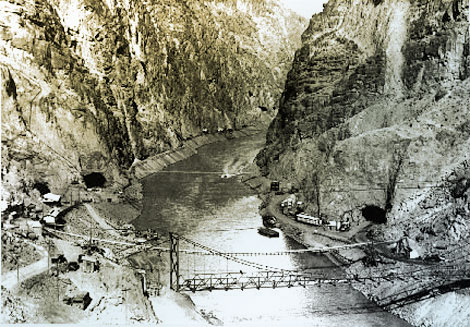 This view of the Black Canyon damsite looking downstream shows preliminary work preparing the site for construction. The two tunnels can be seen that will divert water around the construction site. (Reclamation photograph)
This view of the Black Canyon damsite looking downstream shows preliminary work preparing the site for construction. The two tunnels can be seen that will divert water around the construction site. (Reclamation photograph)Challenges and Compromises
Hoover Dam was born from early settlers' dream of maintaining a stable, year-round water supply to help them live and thrive in the arid American Southwest. The dam was constructed during an era of doubt and insecurity, when Americans were suffering through The Great Depression. It was also built in the face of much opposition. Some critics claimed that it would take years for the power market to absorb the energy produced by the dam, making it economically unfeasible. Others believed that the massive weight of the dam and reservoir would set off a series of catastrophic earthquakes, while still others warned of the complete destruction of lands below the dam if it failed.
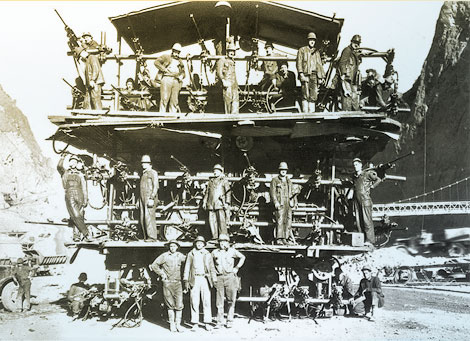 This special drilling rig was designed to speed up the drilling of tunnels. (Reclamation photograph)
This special drilling rig was designed to speed up the drilling of tunnels. (Reclamation photograph)Well before construction, surveyors explored several sites for the dam. Despite summer temperatures of 125° F on the canyon floor, cloudbursts, high winds, and sudden floods that battered engineers, the preliminary work was accomplished over a 7-year period. In 1928, the Black Canyon site was selected.
Even with a preferred dam site, the legislative aspects of the project remained to be solved. The most difficult challenge was the equitable division of the waters of the Colorado River among the seven basin states through which the river runs. The Colorado River Compact was reached in 1922, and the Boulder Canyon Project Act was signed in 1928; these agreements were enough to get construction started. The devil was in the details, however, and it would be decades until the details of how the water would be distributed were finally worked out.
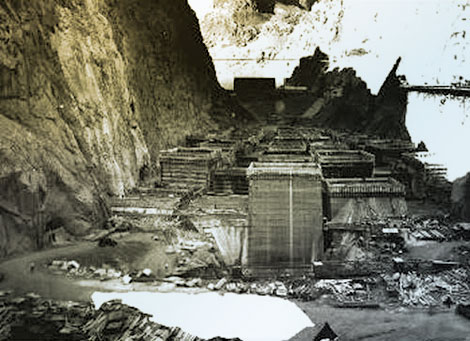 The foundation for the huge dam begins to take shape as the first of 3,250,335 cubic yards of concrete is poured. (Reclamation photograph)
The foundation for the huge dam begins to take shape as the first of 3,250,335 cubic yards of concrete is poured. (Reclamation photograph)Before construction could begin, the Secretary of the Interior was required to find adequate financing to provide revenues for operation and maintenance of the facility. The revenues also had to be sufficient to repay, within 50 years, the monetary advances invested by the federal government for the dam's construction. After months of study and complicated computing, a competitive rate for the power to be generated at Hoover was set. Bids for the power contracts pitted state against state and public against private interests, but after seven months, things were worked out and construction could begin.
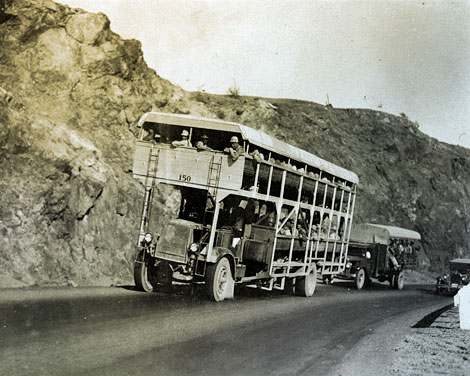 The massive size of the dam construction project called for special equipment. In order to get the thousands of workers to the damsite, vehicles capable of carrying from 100 to 150 men were used. (Reclamation photograph)
The massive size of the dam construction project called for special equipment. In order to get the thousands of workers to the damsite, vehicles capable of carrying from 100 to 150 men were used. (Reclamation photograph)There were still other details to take care of. An infrastructure of living quarters, roadways, railroads, and transmission lines had to be developed at the remote desert site. This included construction of Boulder City to house government and contract employees; seven miles of 22-foot-wide asphalt highway from Boulder City to the dam site; 22.7 miles of railroad from Las Vegas to Boulder City; and a 222-mile-long transmission line from San Bernardino, California, to the dam site to supply electricity for the work. As if this was not daunting enough, the dam was to be built in one of the most rugged and inaccessible sites ever selected for such a project. Transporting men, machines, and material into the canyon was a logistical nightmare made more difficult by 30 miles of desert between the dam site and the nearest town.
Brilliant Innovation
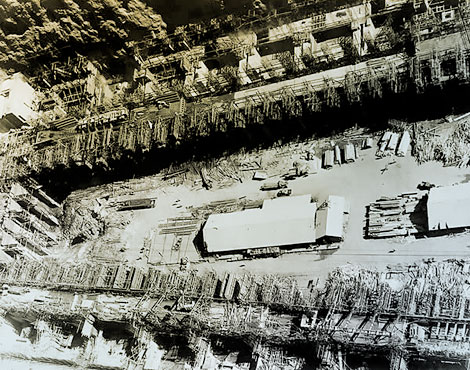 A bird's eye view of the power house under construction. (Reclamation photograph)
A bird's eye view of the power house under construction. (Reclamation photograph)At the time, Hoover was the largest dam ever constructed. It was also the most expensive construction contract ever let by the federal government. The unprecedented size of the dam led to studies of almost every aspect of dam construction including concrete composition and cooling, stress analysis, hydraulic design, and hydraulic and structural modeling. Even the form of the contracting organization was a new development that changed the face of the construction industry. Too large for a single contractor, the project required the formation of a joint venture of six contractors, pooling their talents and resources, and sharing the risks. This organizational structure became a model for future large construction contracts.
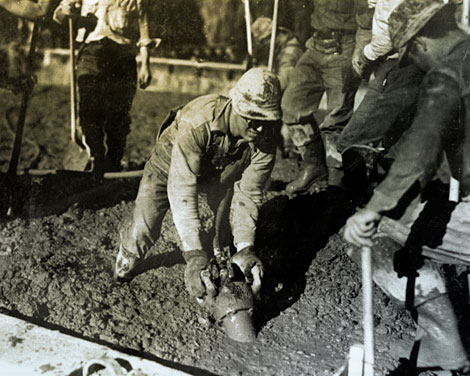 When concrete is poured, it is important to eliminate air pockets. Here workers use a vibrator to settle the concrete and remove air pockets. (Reclamation photograph)
When concrete is poured, it is important to eliminate air pockets. Here workers use a vibrator to settle the concrete and remove air pockets. (Reclamation photograph)Hoover Dam was a project that demonstrated to America and the world that construction of such a large dam was possible. And the numbers associated with the project demonstrate this magnitude: 5.5 million cubic yards of material were excavated; 4.4 million cubic yards of concrete placed; 45 million pounds of reinforced steel used; and 21,6 million pounds of gates and valves installed. Over 44 million tons of steel were formed and welded into 14,800 feet of penstock and outlet pipes. The average number of people employed on the project was 3,500 with over 5,000 employed during the peak of construction.
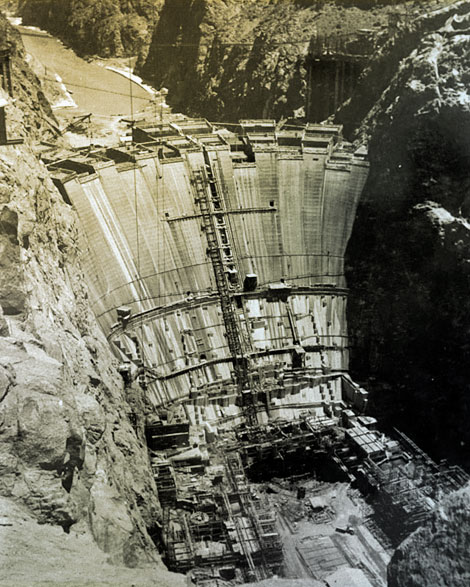 View of the downstream face of the dam with the powerhouse under construction. (Reclamation photograph)
View of the downstream face of the dam with the powerhouse under construction. (Reclamation photograph)In less than two years, 5,000 men using new concrete technology built a structure greater in volume than the Great Pyramid in Egypt which, according to Herodotus, required 100,000 men working 20 years to complete.
A Lasting Monument
Hoover Dam served as a prominent symbol of America's greatness and ability to overcome the economic depression that stuck a severe blow to the country's morale. It was designed to be more than just a working dam, and its Art Deco-style aluminum, steel, and brass features were blended to make it a dramatic and beautiful testament to man's resourcefulness. In an era of Depression-impacted civil works projects, the exquisite workmanship and unique detail that went into every aspect of the structure made Boulder Dam a lasting, impressive icon of American ingenuity.
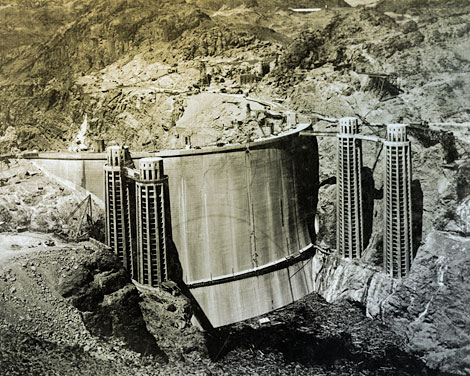 A view of the upstream face of the dam near completion of construction. The four intake towers are visible through which water is sent via the penstocks to the generators. (Reclamation photograph)
A view of the upstream face of the dam near completion of construction. The four intake towers are visible through which water is sent via the penstocks to the generators. (Reclamation photograph)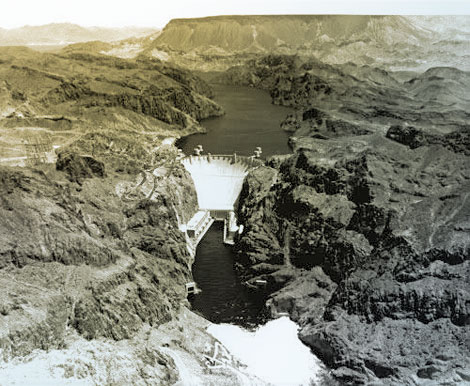 The finished dam looking upstream with the power plant at the base of the dam. (Reclamation photograph)
The finished dam looking upstream with the power plant at the base of the dam. (Reclamation photograph)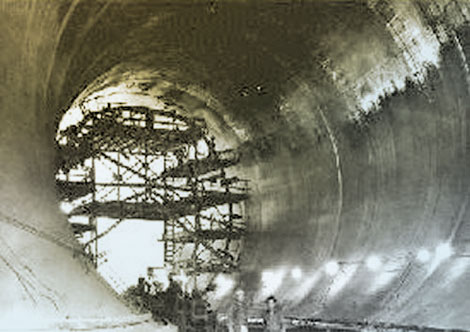 Four 50 ft. diameter diversion tunnels, two on each side of the canyon, were drilled through rock to carry water around the construction site. Upon completion, each tunnel was lined with 3 feet of concrete. (Reclamation photograph)
Four 50 ft. diameter diversion tunnels, two on each side of the canyon, were drilled through rock to carry water around the construction site. Upon completion, each tunnel was lined with 3 feet of concrete. (Reclamation photograph)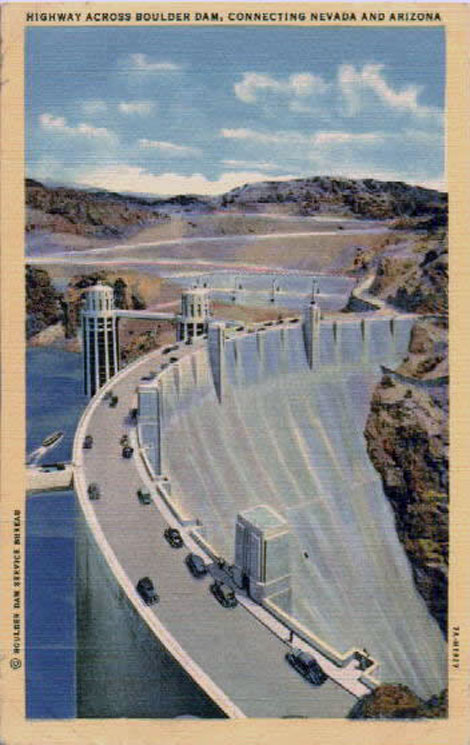 Postcard view of the completed dam, a popular tourist attraction.
Postcard view of the completed dam, a popular tourist attraction.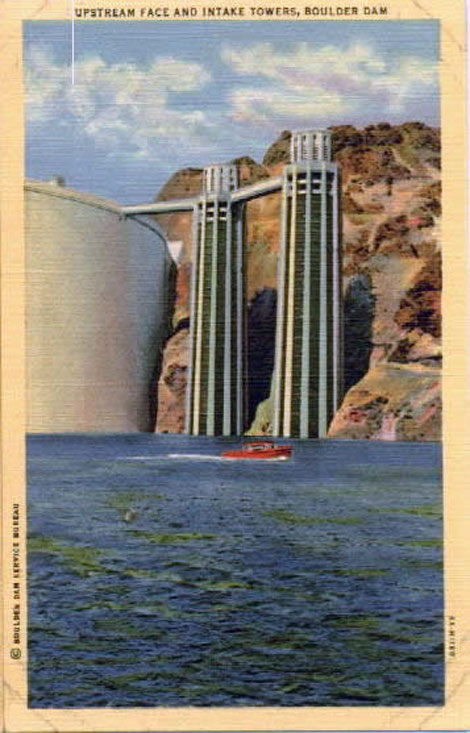 Postcard view of the completed dam, a popular tourist attraction.
Postcard view of the completed dam, a popular tourist attraction.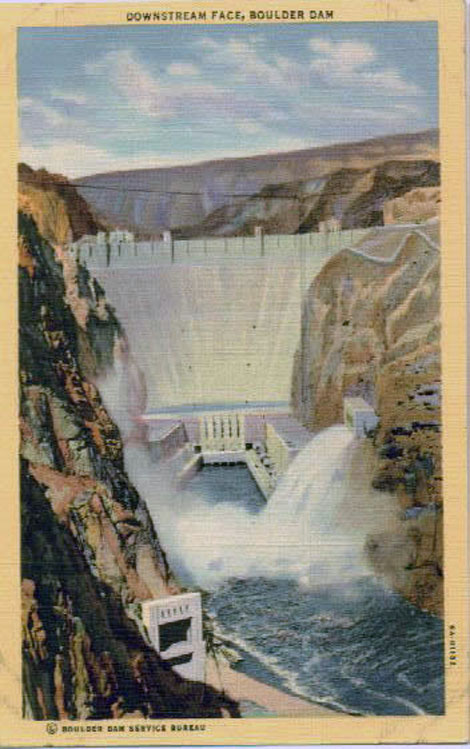 Postcard view of the completed dam, a popular tourist attraction.
Postcard view of the completed dam, a popular tourist attraction.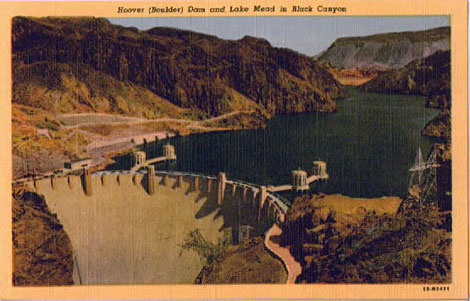 Postcard view of the completed dam, a popular tourist attraction.
Postcard view of the completed dam, a popular tourist attraction.